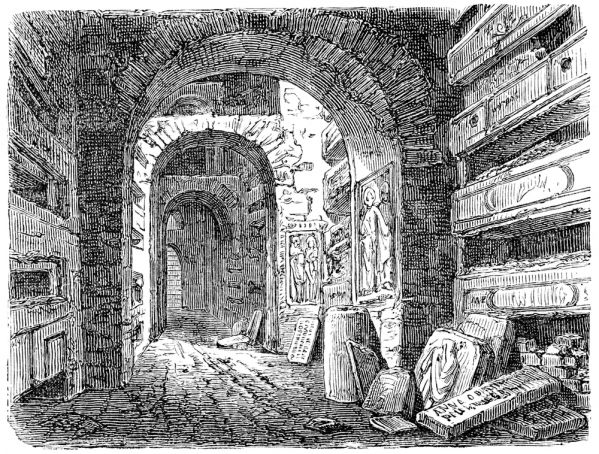All you need to know about Catacombs in Rome
Catacombs are large underground cemeteries used by Christian and Jewish communities between the 2nd and the first half of the 5th century.
The largest complex of catacombs is found in Rome, hosting approximately 60 excavations. Visiting these ancient cemeteries through their long tunnels and passages, allows tourists and locals to explore the rituals, customs, and traditions of the ancient Romans.
The ancient term to designate these monuments is “coemeterium”, which derives from Greek and means “dormitory”, as for Christians the burial of the corpses is a temporary moment awaiting the final resurrection. In fact, while the pagans used to cremate the bodies of the dead, the Christians chose to be buried believing in Christ’s resurrection and the day of judgement.
In Ancient Rome, a law prohibited burying the dead inside the city for architectural and health reasons. Therefore, the construction of the first catacombs began when Pope Zephyrinus, in charge between 199 A.D and 217 A.D, entrusted deacon Callisto with the task of supervising the cemetery of the Via Appia, marked as the location where the most important pontiffs of the 3rd century were buried.
These underground structures were excavated into tuff, a fragmental rock easy to dig into, as it consists of the smaller volcanic detritus which is usually less stratified than solid grounds. For this reason, catacombs are mostly found in central Italy, as well as in its islands, as there is a high concentration of tuffaceous soils.
The access to the catacombs consists of stairs that lead to enclosed galleries with vaulted ceilings that extend to a vast network of corridors and chambers.

The loculi represented the most humble and egalitarian sepulchral system to respect the sense of community across the Christian community; however, there are also more complex tombs, such as “arcosolia”, which involve the excavation of an arched niche larger than loculi in spaces called cubicles, that are mostly found in burial chambers rather than across the walls.
The architectural and artistic structure of catacombs reflect the iconographic Christian tradition that attracts tourists from all over the world and locals to discover, explore and live through ancient Rome’s customs and rituals. If you’re coming to Rome, consider visiting its catacombs as they could deliver an unforgettable experience and expand your vision of the past. Here is a list of the must-see catacombs in Rome:
1) Catacombs of San Callisto
They are considered the most beautiful, imposing, and famous catacombs in Rome. It is the first burial place of Christians and considered an archaeological treasure in the heart of Appia Antica. It houses a network of tunnels that extends for more than 20 kilometers including the burial places of 16 popes and dozens of Christian martyrs.
Opening hours: Every day except for Wednesday (9am to 12pm) - (2pm to 5pm)
2) Catacombs of San Sebastiano
It was the first underground cemetery to be called “catacomb”, as it was initially named “ad catacumbas”, which means “near the hollows”. It was later dedicated to the martyr and saint Sebastian, a soldier persecuted by Roman Emperor Diocletian after discovering he had been converting many soldiers to Christianity and who is buried in these catacombs.
Address: Via Appia Antica, 136
Opening hours: From Monday to Sunday (9:30am to 5pm)
3) Catacombs of Santa Priscilla
Known in all the ancient topographical and liturgical documents, its entrance is next to the convent of the Benedictine Sisters of Priscilla. Due to the number of martyrs buried here, this cemetery was called “regina catacumbarum”, meaning “the queen of the catacombs”. In fact, they are located 35 meters below the ground level and house about 40 thousand burials, including six Popes: St. Marcello I, St. Sylvester I, St. Liberio, St. Siricio, St. Celestino I and Vigilio.
Address: Via Salaria, 430
Opening hours: From Tuesday to Sunday (9am to 12pm) - (2pm to 5pm)
4) Catacombs of Praetextatus
They are the most famous from an artistic and iconographic point of view and can only be visited through appointment. The main gallery composing the catacombs is called “Spelunca Magna”, which means “large cave”and is believed to having been an abandoned cistern later adapted as an underground burial ground.
Address: Via Appia Pignatelli, 11
Opening hours : Every day (8am to 8pm)
5) Catacombs of Santa Tecla
They are located near the Basilica of San Paolo and are famous for the frescos depicting Jesus with two apostles on his sides. In 2010, the oldest depictions of apostles Peter, Andrew and John were found, being at least 1,700 years old.Although they are not among the largest in Rome, these catacombs are very important from an archaeological point of view. In fact, there are only 22 rooms, but they are almost all entirely covered in beautiful frescoes. If you want to visit, you’ll need to request an appointment. To reach these catacombs you can take the 75 bus to the Marmorata/Vanvitelli stop and then switch to the 23 bus until the Ostiense/Valco S. Paolo stop. At this point, you will only have to walk for 4 minutes before reaching the destination.
Address: Via Silvio D'Amico, 42
Opening hours: Visit available under request
If you think you’ve explored all of Rome, there is even more to see beneath the surface, where the ancient world is still preserved to this day. When walking through the dark and humid corridors, the loculi and inscriptions with the names of the deceased will make you think about the life of the past and will offer you an unforgettable experience.
Main Ph: Alessandra C84 / Shutterstock.com

















